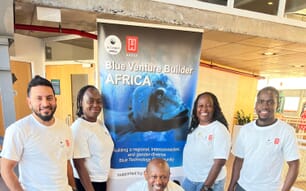Identity
Mytilus galloprovincialis Lamarck, 1819 [Mytilidae]
FAO Names: En - Mediterranean mussel, Fr - Moule méditerranéenne, Es - Mejillón mediterráneo

Biological features
Equal to Mytilus edulis but separated by the following characters: a) the umbones turning downwards tending to make the basal line of the shell concave; b) the valves are higher and less angular on the upper margin and tend to grow larger; c) the mantle edge darker, becoming blue or purple.
View SIDP Species fact sheet
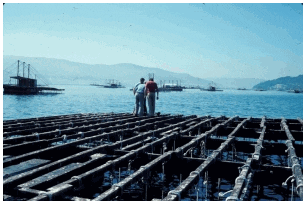
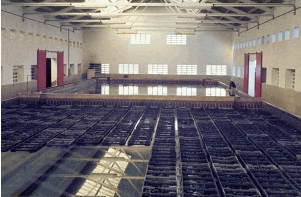
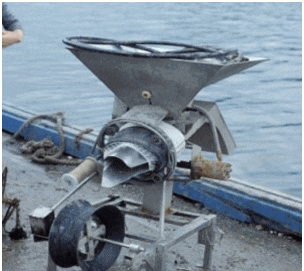

Profile
Historical background
The area of the world with the highest production of Mytilus galloprovincialis is China (see section on production below) but little information is available so the information from Galicia (NW of Spain) has been used to prepare this informative sheet. The earliest evidence of mussel consumption in the Galician Region has been dated in the fourth century B.C., when the natives left large deposits of bivalve mollusc shells including mussels.
These deposits have been denominated 'concheiros' and have also been found near to the Roman villages of the first century A.D. In the 16th century, people from Portugal came to the ria of Arosa, in Cambados, to gather mussels, clams, and cockles. Mussels became important in Spain when farmers began culturing them at the beginning of the 20th century.
The first mussel culture was practiced in Tarragona and Barcelona (N.E. of Iberian peninsula) in 1901 and 1909, respectively, using poles similar to those used in France. After the first trials, this system was abandoned and use of floating structures began. At this time, the natural populations of mussels in the Galician rias were used mainly as manure on farms and, on a limited scale, as a source of mussel seed to be cultured. There were a few parks where farmers practiced bottom culture of mussels; the mussels were sold along the Mediterranean coast. In 1946, raft culture of mussels was introduced in the Galician region and within a few years production increased sharply.
The early rafts consisted of square wooden frameworks supported by a central float and restored old ships that supported wooden frameworks, from which farmers hung ropes of esparto grass (Stipa tenacissima). Farmers attached mussel seed to the ropes, and when the seed reached commercial size, they collected them by hand or with a special pin wheel. Subsequently, the old ships were replaced by square or rectangular wooden frameworks supporting small houses. Flotation consisted of wooden floats wrapped in wire mesh and coated with concrete. Today, a few old rafts remain, but most of the new ones are constructed of a framework of eucalyptus wood.
Main producer countries
Mytilus galloprovincialis is mainly cultured in coastal waters from Galicia (NW Spain) to the northern shores of the Mediterranean Sea. However, production has also been reported from some southern Mediterranean countries, the Russian Federation, Ukraine, and South Africa. This species is also cultured in China. (Please refer to the note contained in the section on production, which explains why Spain and China do not appear on the following map.)
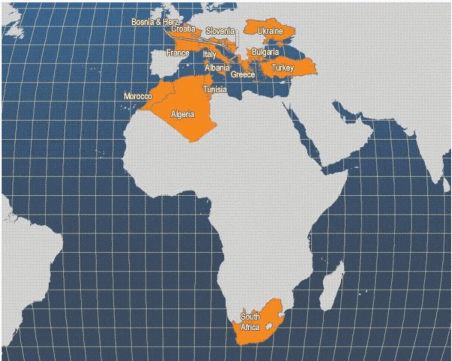
Habitat and biology
The habitat of the locations where culture takes place is very similar. Galicia (NW Spain) has been taken as a model in this fact sheet. The Galician coast is characterised by flooded river valleys called 'rias', where farmers culture the mussels. Rias are up to 25 km long, between 2 and 25 km wide, and from 40 to 60 m deep; their bottoms are muddy, and they are bordered by hills. Annual productivity in the rias averages 10.5 mg carbon/litre/hr. The temperature ranges from 10-20 °C, salinity is around 34‰, and the tidal range averages 4 m. Tidal currents are strong. There is a continuous upwelling of cold water that is rich in nutrients; these, along with nutrients which wash down from the hills during heavy rains (mean annual precipitation is 1250 mm) probably stimulate an abundance of phytoplankton. In turn, this favours the growth of mussels. These sheltered rias provide an ideal environment for culturing mussels on ropes suspended from floating rafts.
The most important culture area is the ria de Arosa which is responsible for 60 per cent of Spanish mussel production; it is followed by ria de Vigo and ria de Pontevedra. Natural populations of mussels are present in large areas in the mouths of the rias and islands on intertidal rocky shores, where the mean density in the most crowded beds is around 24 000 mussels/m². They also grow along the rias mainly on rocky areas, cliffs, and boulders. Farmers collect mussel seed from these areas to suspend from their rafts. Recruitment of seed mussels occurs throughout the year with the major settlement season from May to September.
Mussels can move with the aid of the foot. A byssus gland secrets byssal threads that allow their attachment to the substrate. The gills are two pairs of broad plates composed of a large number of parallel filaments that filter food particles from the water. A mussel of 5 cm in length can filter 5 litre/hr. Digestion takes places in the digestion gland (brown-greenish in colour) situated in the centre of the body.
Mussels feed on phytoplankton and organic matter. The mantle, immediately in contact with the interior of the shell, secretes the shell and contains the gametes (eggs or sperm). In Galicia, reproduction may take place at any time of the year. Mussels produce millions of eggs, losing a considerable amount of their reserve glycogen. Recently spawned mussels are so lean that they cannot be marketed. Fertilisation is external. Fertilized eggs develop into a trochophore larvae, and then into a veliger that is carried by tide and currents. When they reach a shell length of 0.25 mm the pediveligers attach themselves with their byssus threads to filamentous substrates. They are able to detach themselves and reattach to other substrates.
Production
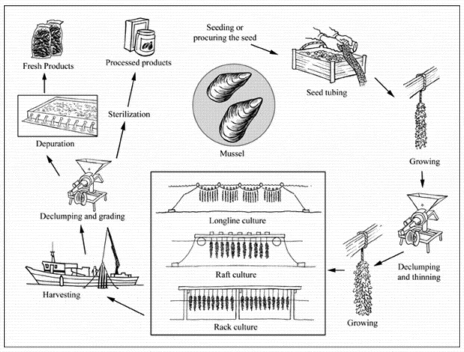
Production systems
The rearing of Mytilus galloprovincialis is always extensive, in all countries where it is being carried out; the steps that are described in this fact sheet therefore apply to all cases. The young mussels are collected from the sea and can be cultured on suspended ropes; these ropes, which are covered with mussel seeds kept in place by nylon nets, are suspended either from rafts, or wooden frames, or from longlines of floating plastic buoys. A substantial portion of the EU production is grown on suspended ropes, a technique which can be extended further offshore and which, although quite sensitive to plankton blooms, is the only one which could further increase production.
Seed supply
Culture begins when farmers collect mussel seed, mainly from natural beds (60-70 per cent); the remainder from the collector ropes hung from their rafts. Farmers can collect up to 1 500 kg of seed per low tide in about 4 hours, from the exposed rocky shores on the ocean side of the rias and islands. They use a special steel shovel, called a 'rasqueta', which has a blade of about 10 cm², attached to a wooden handle. Farmers suspend the mussels from their own rafts or sell them to other farmers. The price is about 60 pesetas/kg (EUR 1 = 166.386 pesetas). Farmers gather around 4 500 tonnes of mussel seed (mean length = 2 cm) from these areas every culture cycle. They take the seed to the rafts, keeping it moist, and attach it to ropes within 24 hours after collection. To collect seed from the rafts, farmers use special nets made from old fish nets and suspend them during March and April.
Ongrowing techniques
In Galicia, Mytilus galloprovincialis is cultured in rafts. Raft size varies considerably from <100 m² to >500 m². These structures are supported by floats (from one to six), constructed of wood or steel covered with fibreglass or polyester, or filled with expanded polyester. Depending on the number of floats, the usable culture area can go from 80 per cent, when a central float is used, to 90 per cent when four to six floats are used. Farmers secure the rafts with one or two iron chains and a 20 tonnes concrete anchor. In protected areas with little boat traffic, they use only one mooring chain. Two chains are better in exposed areas or when the rafts are near the shore or heavy boat traffic. The rafts are located together, but separated from each other by about 80-100 m, in groups called parks. These vary in the number of rafts, and their locations are regulated by marine authorities.
From the beginning of mussel culture in 1946, the number of rafts increased moderately to 400 in 1956 but, after that, they increased rapidly. The average size of the rafts increased from 297 m² in 1977 to 369 m² in 1984. Currently, farmers work from shallow-draft, wide-beam boats (9 tonnes in weight), powered by diesel engines of about 24 hp. Each has a basket and crane to raise the ropes and machines to separate and thin the mussels. Special machinery has been developed to help with the various culture practices, especially with the wrapping of spat to the ropes, and grading.
Attaching the seed
Farmers attach the seed to the ropes by hand, or with a machine which secures it with a special cotton or rayon mesh; this mesh disintegrates within a few days. By then, the mussels have secreted new byssus and have attached themselves to the ropes. Farmers attach from 1.5-1.75 kg of seed/per metre of rope, and the average weight of seed for each rope is 14 kg. The ropes, usually 3 cm thick and made of nylon, polyethylene, or esparto grass (S. tenacissima), vary in length from 6-10 m. Their rough surfaces facilitate the attachment of the mussels. Each rope with attached mussels has a loop at one end, which is fastened to a thinner polyester rope called a 'rabiza' (12-14 mm thick), which in turn is lashed to the girders of the rafts. The rabiza usually lasts only 3-4 years because it is exposed to air and sunlight, while the major ropes last an average of 5.8 years. Each raft has from 200 to 700 ropes. Every 30-40 cm, wooden or plastic pegs 20-30 cm long are inserted between the strands of the ropes to prevent the clumps of mussels from sliding down. Farmers attach from 1-3 ropes/m² of raft. This distribution allows an adequate flow of water rich in food for the mussels, and prevents the mussel ropes from touching each other. Farmers install the ropes mainly from November to March.
Thinning
The third step (after obtaining the seed and attaching it) is thinning, which has to be done to prevent the mussels from falling off in rough weather; thinning also encourages rapid and uniform growth. Farmers do this when the mussels are half grown (shell length 4-5 cm) after 5-6 months of growth, usually from June to October. They lift the ropes into their boats using a crane and rub off the clusters of mussels by hand into a steel screen which separates them into different sizes. A mechanical cylindrical screen may also be used. The mussels from each original rope are attached to two to four new ropes with cotton or rayon netting. The average weight of the ropes is 46 kg. Those farmers who automate this operation spend 5-15 seconds per metre of rope, or less than 14 hours for 500 ropes of 10 m length. This work is repeated once again before harvesting if the mussels grow rapidly (in which case their weight and density increases the risk that the mussel clusters will fall off). It is also necessary to repeat this operation in order to ensure that all mussels reach a similar size at harvest time.
Rearing
The rearing of mussels constitutes the fourth culture step. In the Galician region where growth is rapid, mussels can attain market size (8-10 cm) in 8-9 months, especially in the areas closest to the ocean side of the rias. The usual time required in some bays is around 13 months. However, a high raft density can retard mussel growth. Growth is minimal in summer and highest in winter. Slow summer growth is related to the relative abundance and availability of food (phytoplankton) in the water column then; this is more important than high temperature and causes the seed placed on the ropes in the spring and the fall to reach the same size at the end of the first winter.
Each raft normally holds three types of ropes: those for collecting seed, those with growing mussels, and those with marketable mussels; in this way, growers maintain continuous production. Since the mussels grow faster near the water surface, some growers periodically invert the ropes to produce mussels of about equal size. In rafts with only one central float, the equilibrium of the raft is altered when farmers raise ropes for thinning or harvesting, and they have to put containers filled with water on the appropriate area of the framework to avoid tilting them. A large number of mussel seed and fouling organisms attach to the floats and, as they grow, the weight of the raft increases; therefore farmers have to clean the floats occasionally. This process is easiest when the raft is nearly empty and it floats higher, leaving many mussels and fouling organisms exposed to air where they die and are easy to remove. For major repairs of the framework or floats, farmers take the rafts to shipyards or factories. A medium-sized wooden raft has a life span of 10-15 years, while modern fibreglass rafts last considerably longer. Rafts range in age up to 30 years, with an average of about 8 years.
Harvesting techniques
Mussels of commercial size are available throughout the year and can be harvested at any time but the main harvest is from October to March, when market demand is high and their condition is best. Meat weights can approach 50 per cent of total wet weight when the mussels are in best condition. When a large percentage of mussels is close to spawning or just past spawning, harvesting should wait until they are in better condition. The mean production averages 130 kg/m² of raft area; for an entire raft this equates to 20-100 tonnes, with a mean value of around 47 tonnes. Such values are highly variable and depend on size of the rafts. Production can also be defined as about 10 kg of mussels per metre of rope. Annual losses (natural mortality and handling) have been estimated at 15 per cent. Recent experimental results show that natural mortality in mussels is around of 5 per cent.
For harvesting, farmers use a crane to raise the ropes to their boat, where the mussels are separated and graded by rubbing them over a grid of iron bars. They are then washed clear of small mussels, silt, empty shells, ascidians, and other unwanted organisms. Any mussels too small for the market are wrapped onto new ropes for further growing.
Handling and processing
The marketable mussels are packed by women in nylon bags and taken in boats directly to the depuration plants, or to canning factories. Women usually do all of this work. Each handles about 200 kg of mussels every 8 hours. The mechanization of handling is minimal to reduce damage to mussel shells, and thereby enhance the shelf life of the mussels during transportation. In the warm season, refrigerated trucks are used to transport the mussels. Sometimes, mussels for the Spanish market are transported by train. The mussels that go directly to the canneries are those having the poorest quality and size. They are prepared by frying or boiling and then covered with various sauces; they can be served in a large variety of ways.
Production costs
The cost of a floating raft is governed by its size and the materials used. In 1948 a single raft with all the equipment, including 800 ropes, cost around 83 000 pesetas. In 1958 its cost had reached 250 000 pesetas; of this, 150 000 pesetas were for carpentry, 21 000 for the chain and anchorage, 65 000 for the esparto grass ropes (S. tenacissima), and 14 000 for the boat and incidentals. In 1976, the cost was from 1 500 000 to 2 000 000 pesetas; in 2000, their cost was about 15 000 000 pesetas.
The price of fresh mussels in 1951 ranged from 2.0 to 2.5 pesetas/kg, and in 1958 from 3.5 to 3.75 pesetas/kg. In 1976, the price directly from the rafts was from 7.5 to 9.1 pesetas/kg, and at the first sale the price reached 15-20 pesetas/kg. The price to the consumer was about 30 pesetas/kg. By 2000, the price for the consumer is around 180 pesetas/kg. These prices are very low when compared with prices for other kinds of shellfish or meat. The profits for a family have been calculated as about 25 per cent of the total value of the production sold.
[Note: costs and values are given in pesetas because of differential temporal exchange rates]
| DISEASE | AGENT | TYPE | SYNDROME | MEASURES |
|---|---|---|---|---|
| Marteiliasis; Marteiliosis; Aber disease | Marteilia maurini; M. refringens | Protozoans | Visceral tissues lose pigmentation, becoming pale yellow; mantle sometimes translucent; shell growth may cease; flesh shrunken & slimy | No treatment available; avoidance of stock transfer from infected areas; regulations |
| 'Red worm' disease | Mytilicola intestinalis | Copepod | Commensal organism; mussels thought to be unaffected | No known measures |
Neither of the diseases listed above causes serious harm to the culture of M. galloprovincialis. The associated species that occur in the natural mussel beds are those found on rocky intertidal shores, such as barnacles (Balanus sp.) and algae (Enteromorpha sp.).
Mussel predators include crabs, Carcinus maenas, starfish, Asterias rubens, and sea birds. The associated species that colonise the mussels on ropes suspended from rafts, by means of planktonic larvae or crawling, are crustaceans such as the decapod Pisidia longicornis, amphipods (Phtisica marina and Eurystheus maculates), ascidians (Ascidiella aspersa and Ciona intestinalis) and encrusting species such as balanids and polychaete worms (Pomatoceros sp. and Elminius modestus).
They compete with each other for space and food and some can invade the mussel shells. Damage from crabs and starfish is slight, but occasionally A. rubens and Nucella lapillus, a gastropod, occur on the ropes. In addition, some fishes, such as the sparid Diplodus sargus, and gilthead seabream, Sparus aurata, occasionally damage adult mussels by crushing their shells; they also eat seed mussels.
Suppliers of pathology expertise
No information supplied.
Statistics
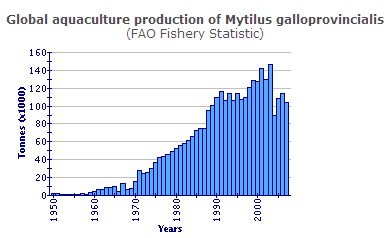
The data provided in the chart represents the statistical returns made by FAO Member States relating to M. galloprovincialis. No data were submitted for this species by Spain or China. Substantial quantities of mussels are produced in China (e.g. more than 663 000 tonnes in 2002) and reported under the statistical category 'sea mussels nei'; these are mostly Mytilus galloprovincialis, with small amounts of M. coruscus, Musculus senhouse and Perna viridis. The substantial mussel production of Spain (e.g. 201 025 tonnes in 2002) is reported to FAO as M. edulis but the author of this fact sheet states that nearly all of this is in fact M. galloprovincialis.
Author's comment: Up to the early 1990s, all mussels from Western Europe were considered to be Mytilus edulis. Now we know that the mussels from southern Brittany (France) to the Mediterranean Sea are M. galloprovincialis. The statistical records from FAO and other institutions do not take this fact into account. This is one of the reasons for confusion. In addition, limited information about Chinese mussel culture technology and practices in Western literature make analysis difficult.
Market and trade
There are two mussel markets in the region: a fresh market before depuration and a processed market. Larger quantities of mussels are marketed fresh, but the canning market has expanded since 1984.
Depuration stations sell their mussels to central markets, from which they are sold to restaurants and consumers. The remaining mussels are sent to markets outside Spain.
The processed market consists of trade in canned mussels, as well as preserved (boiled and preserved in sterilised brine), and frozen products. The cans (about 115 g) are sealed, cooked (sterilised) in a retort, labelled, and packed in shipping cases for worldwide distribution. The marketing of canned mussels more than doubled from 1984 to 1989.
Mussel markets have been changing. At the beginning of mussel farming in Spain national consumption was limited but has now exceeded 100 000 tonnes annually, mainly as fresh mussels. The distribution of mussels was approximately 40 per cent for the fresh market (76 per cent of these for the local market and 24 per cent for export), 50 per cent for canning (the quantity of canned mussels consumed in the home market was 89 per cent and the remaining 11 per cent was exported), and 10 per cent for freezing. In the past decade, about 60 per cent of mussels have been for the fresh market and 40 per cent for canning. The frozen portion has been increasing and is estimated at 15 000 tonnes per year. Exports are mainly to Italy, France, and Germany. France imported 3800 tonnes of mussels from Spain in 2001 and 4 608 tonnes in 2002, while Italy imported 1 100 tonnes in 2001 and 1 400 tonnes in 2002.
Status and trends
Since 1948 total mussel production in Spain has become the highest of any country in the world, apart from China. It was expected that Spanish production would expand further than it has done but several biological, technological, and socioeconomic factors have affected this prediction. Recently, there has not been a substantial increase in the number of rafts and, while the sizes of rafts and rope size have grown, total production of mussels has not. Thus a production limit is approaching; probably the number of rafts should be controlled. To increase production, suitable new areas must be found.
Main issues
The losses occurring from predation by starfish, crabs, and fishes is not substantial, and the parasites, Mytilicola intestinalis (copepod) and Marteilia sp. (protozoa), have not really affected mussel production. Nevertheless, a permanent programme is needed to study mussel mortalities, prevalence and incidences of parasites, and condition index. Transplants of mussels without assurance that they are healthy should not be made. A special programme is needed for the maintenance of water quality, because an increase in pollution of the water could not only increase the prevalence of parasites but also the levels of toxic substances, such as heavy metals. In this respect, the control programme for red tides must continue, and it is important to evaluate the impact of mussel culture on the environment and on other commercial species.
Also needed is information on distribution and collection of mussel larvae, availability of seed, and related information such as places where larvae set, amount of seed available, and the effect of spat collection on the natural populations and their recuperative capacities, to regulate and control the use of seed for culture. Mussel production can be affected by low salinity which kills mussels on the upper 0.5 to 1 m of the ropes; also, winter storms can damage and even sink the rafts. These problems can be reduced by continuous monitoring of water salinity and the use of better rafts.
Mussel culture could be improved by the use of new materials for raft construction, including:
- Floats and ropes.
- Sinkable rafts designed to permit culture in rough waters, while increasing the culture surface.
- Improved systems that prevent mussel clusters from sliding down the ropes.
- Better machinery for harvesting, transporting, and processing.
However, any technological improvements must take into account the total value to the fishermen in the region; one of the reasons mussel culture is successful now is its low operational costs, due to use of many family members. With high mechanization, many jobs would be lost. On the other hand, Spanish participation in the EU will place additional pressures for changes in socioeconomic structure. Heretofore, the marketing structure has not allowed families to set prices. Only through better group organization would it be possible to change this market structure and give families more control of prices.
Responsible aquaculture practices
An emphasis on environmentally friendly practices should be encouraged. Silting of the bottoms where rafts are located may induce a problem for the benthic communities located underneath. This should be solved by strong policies directed towards correct management of the fouling and silt accumulated by the hanging ropes. The enormous amount of shells produced is being disposed in a variety of industrial ways but more diversification is needed. Biotechnology may prove a useful way of finding new alternatives to fouling and the disposal of shells.
May 2010




